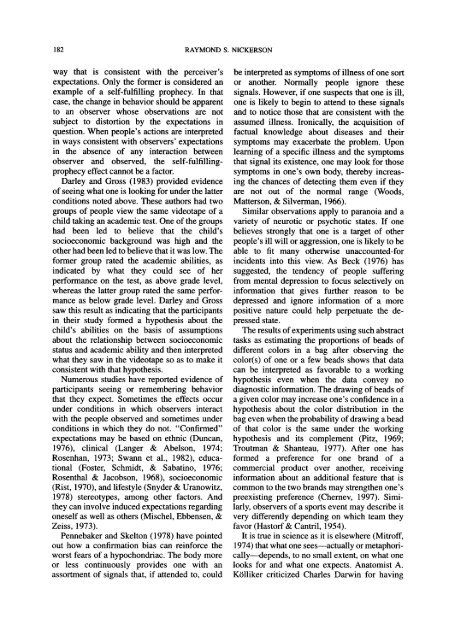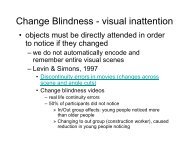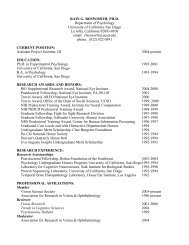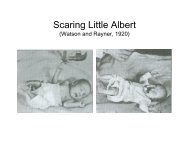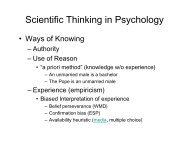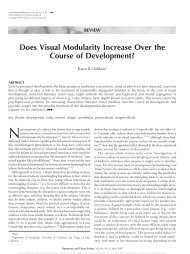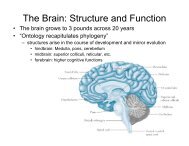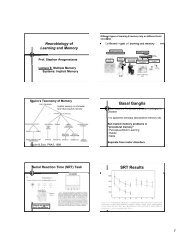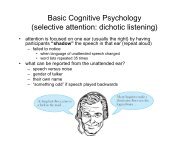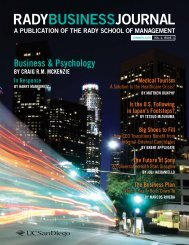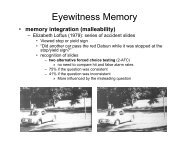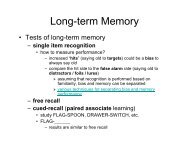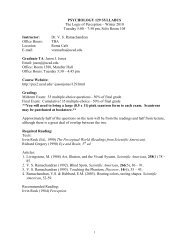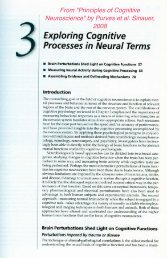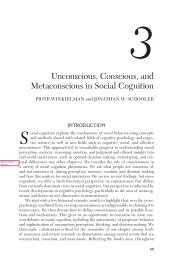Confirmation Bias: A Ubiquitous Phenomenon in Many Guises
Confirmation Bias: A Ubiquitous Phenomenon in Many Guises
Confirmation Bias: A Ubiquitous Phenomenon in Many Guises
Create successful ePaper yourself
Turn your PDF publications into a flip-book with our unique Google optimized e-Paper software.
182 RAYMOND S. NICKERSON<br />
way that is consistent with the perceiver's<br />
expectations. Only the former is considered an<br />
example of a self-fulfill<strong>in</strong>g prophecy. In that<br />
case, the change <strong>in</strong> behavior should be apparent<br />
to an observer whose observations are not<br />
subject to distortion by the expectations <strong>in</strong><br />
question. When people's actions are <strong>in</strong>terpreted<br />
<strong>in</strong> ways consistent with observers' expectations<br />
<strong>in</strong> the absence of any <strong>in</strong>teraction between<br />
observer and observed, the self-fulfill<strong>in</strong>gprophecy<br />
effect cannot be a factor.<br />
Darley and Gross (1983) provided evidence<br />
of see<strong>in</strong>g what one is look<strong>in</strong>g for under the latter<br />
conditions noted above. These authors had two<br />
groups of people view the same videotape of a<br />
child tak<strong>in</strong>g an academic test. One of the groups<br />
had been led to believe that the child's<br />
socioeconomic background was high and the<br />
other had been led to believe that it was low. The<br />
former group rated the academic abilities, as<br />
<strong>in</strong>dicated by what they could see of her<br />
performance on the test, as above grade level,<br />
whereas the latter group rated the same performance<br />
as below grade level. Darley and Gross<br />
saw this result as <strong>in</strong>dicat<strong>in</strong>g that the participants<br />
<strong>in</strong> their study formed a hypothesis about the<br />
child's abilities on the basis of assumptions<br />
about the relationship between socioeconomic<br />
status and academic ability and then <strong>in</strong>terpreted<br />
what they saw <strong>in</strong> the videotape so as to make it<br />
consistent with that hypothesis.<br />
Numerous studies have reported evidence of<br />
participants see<strong>in</strong>g or remember<strong>in</strong>g behavior<br />
that they expect. Sometimes the effects occur<br />
under conditions <strong>in</strong> which observers <strong>in</strong>teract<br />
with the people observed and sometimes under<br />
conditions <strong>in</strong> which they do not. "Confirmed"<br />
expectations may be based on ethnic (Duncan,<br />
1976), cl<strong>in</strong>ical (Langer & Abelson, 1974;<br />
Rosenhan, 1973; Swann et al., 1982), educational<br />
(Foster, Schmidt, & Sabat<strong>in</strong>o, 1976;<br />
Rosenthal & Jacobson, 1968), socioeconomic<br />
(Rist, 1970), and lifestyle (Snyder & Uranowitz,<br />
1978) stereotypes, among other factors. And<br />
they can <strong>in</strong>volve <strong>in</strong>duced expectations regard<strong>in</strong>g<br />
oneself as well as others (Mischel, Ebbensen, &<br />
Zeiss, 1973).<br />
Pennebaker and Skelton (1978) have po<strong>in</strong>ted<br />
out how a confirmation bias can re<strong>in</strong>force the<br />
worst fears of a hypochondriac. The body more<br />
or less cont<strong>in</strong>uously provides one with an<br />
assortment of signals that, if attended to, could<br />
be <strong>in</strong>terpreted as symptoms of illness of one sort<br />
or another. Normally people ignore these<br />
signals. However, if one suspects that one is ill,<br />
one is likely to beg<strong>in</strong> to attend to these signals<br />
and to notice those that are consistent with the<br />
assumed illness. Ironically, the acquisition of<br />
factual knowledge about diseases and their<br />
symptoms may exacerbate the problem. Upon<br />
learn<strong>in</strong>g of a specific illness and the symptoms<br />
that signal its existence, one may look for those<br />
symptoms <strong>in</strong> one's own body, thereby <strong>in</strong>creas<strong>in</strong>g<br />
the chances of detect<strong>in</strong>g them even if they<br />
are not out of the normal range (Woods,<br />
Matterson, & Silverman, 1966).<br />
Similar observations apply to paranoia and a<br />
variety of neurotic or psychotic states. If one<br />
believes strongly that one is a target of other<br />
people's ill will or aggression, one is likely to be<br />
able to fit many otherwise unaccounted-for<br />
<strong>in</strong>cidents <strong>in</strong>to this view. As Beck (1976) has<br />
suggested, the tendency of people suffer<strong>in</strong>g<br />
from mental depression to focus selectively on<br />
<strong>in</strong>formation that gives further reason to be<br />
depressed and ignore <strong>in</strong>formation of a more<br />
positive nature could help perpetuate the depressed<br />
state.<br />
The results of experiments us<strong>in</strong>g such abstract<br />
tasks as estimat<strong>in</strong>g the proportions of beads of<br />
different colors <strong>in</strong> a bag after observ<strong>in</strong>g the<br />
color(s) of one or a few beads shows that data<br />
can be <strong>in</strong>terpreted as favorable to a work<strong>in</strong>g<br />
hypothesis even when the data convey no<br />
diagnostic <strong>in</strong>formation. The draw<strong>in</strong>g of beads of<br />
a given color may <strong>in</strong>crease one's confidence <strong>in</strong> a<br />
hypothesis about the color distribution <strong>in</strong> the<br />
bag even when the probability of draw<strong>in</strong>g a bead<br />
of that color is the same under the work<strong>in</strong>g<br />
hypothesis and its complement (Pitz, 1969;<br />
Troutman & Shanteau, 1977). After one has<br />
formed a preference for one brand of a<br />
commercial product over another, receiv<strong>in</strong>g<br />
<strong>in</strong>formation about an additional feature that is<br />
common to the two brands may strengthen one's<br />
preexist<strong>in</strong>g preference (Chernev, 1997). Similarly,<br />
observers of a sports event may describe it<br />
very differently depend<strong>in</strong>g on which team they<br />
favor (Hastorf & Cantril, 1954).<br />
It is true <strong>in</strong> science as it is elsewhere (Mitroff,<br />
1974) that what one sees—actually or metaphorically—depends,<br />
to no small extent, on what one<br />
looks for and what one expects. Anatomist A.<br />
Kolliker criticized Charles Darw<strong>in</strong> for hav<strong>in</strong>g


